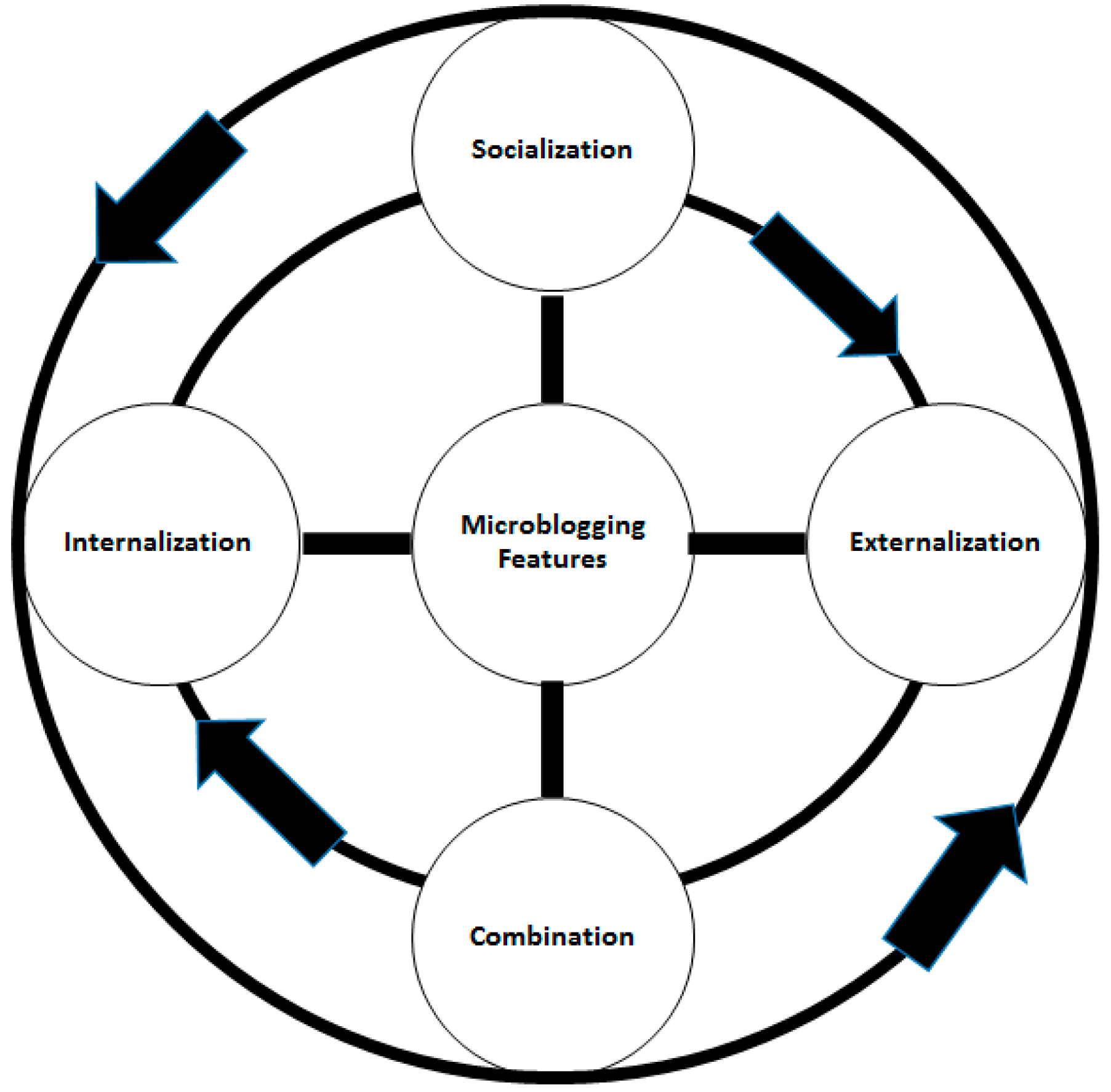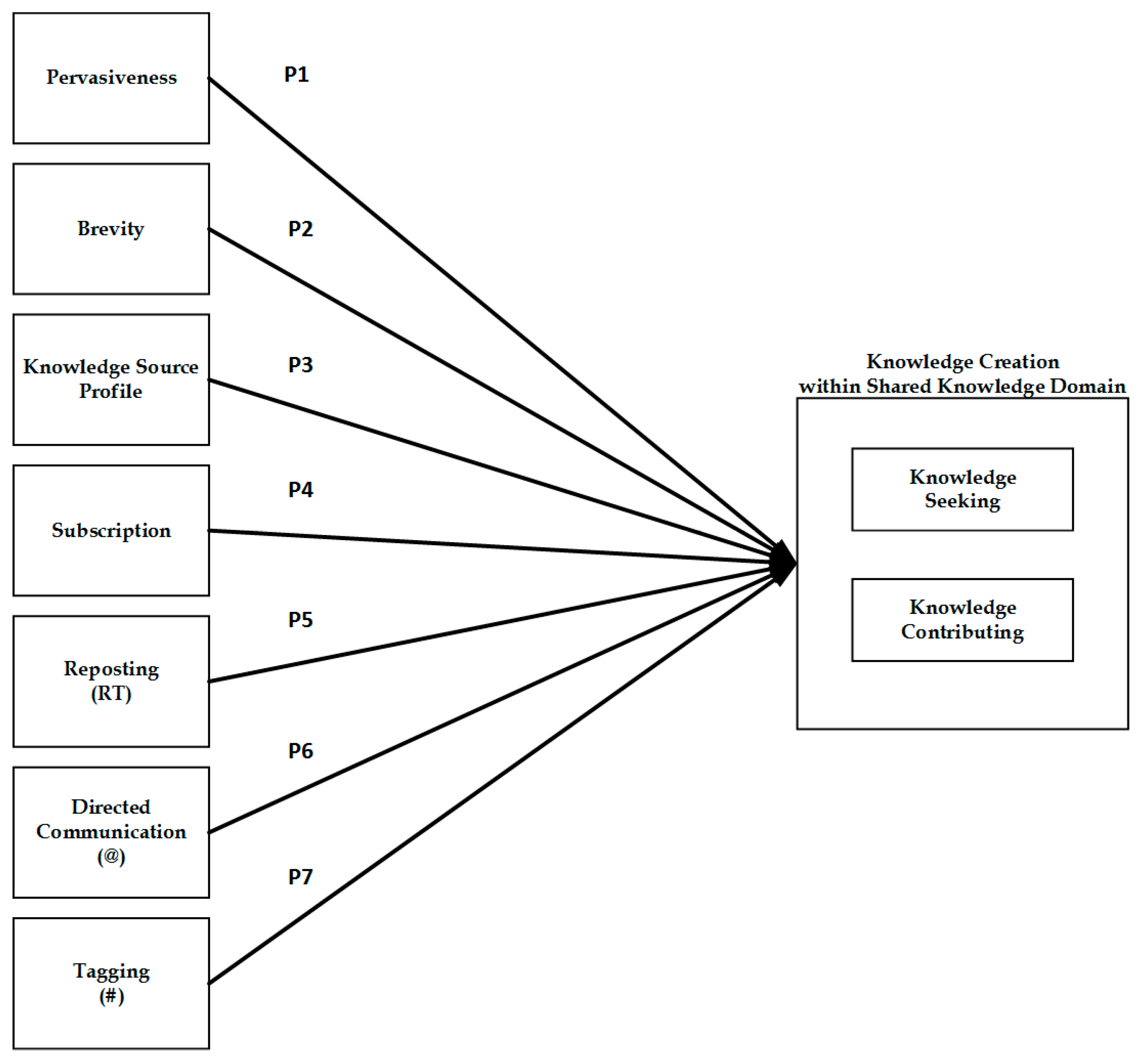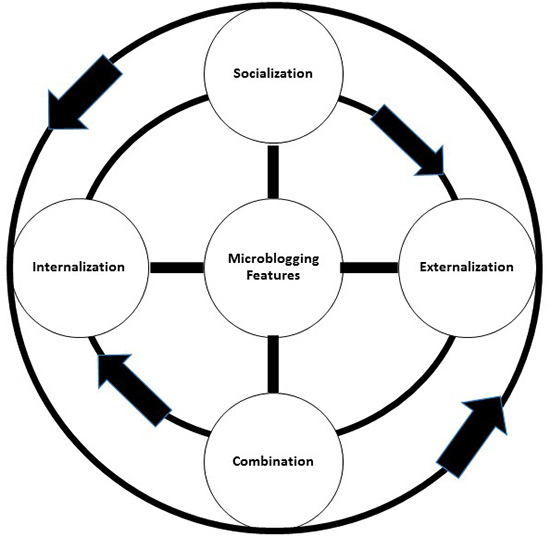Social Media Systems in the Workplace: Toward Understanding Employee Knowledge Creation via Microblogging within Shared Knowledge Domains
Abstract
:1. Introduction
2. Literature Review
2.1. Corporate Knowledge Creation: Knowledge Patterns, Types and Domains
- (1)
- Procedural knowledge—this type of knowledge product consists of rules associated with specific work domain and is expressed via figures, documents, and diagrams;
- (2)
- Situational knowledge—knowledge product of this type encompasses specific scenarios at work that necessitate previously formulated mental models developed through problem solving of various work scenarios. This type of knowledge product is typically acquired through hands-on training;
- (3)
- Conceptual knowledge—product knowledge of this type is associated with archetypal work themes. While some of its explicit properties lend its transfer through pictures and symbols, it requires the knowledge seekers to possess tacit understanding of the work domain;
- (4)
- Strategic knowledge—as with the conceptual type, this knowledge product demands inherent conceptual and abstract understanding of the work domain. Since it is constructed through a series of logical actions, the conversion of this knowledge type necessitates reflection and logical analysis of specific work domain’s artifacts.
2.1.1. Knowledge Creation within the Shared Knowledge Domain
2.1.2. Knowledge Creation Outside of a Shared Knowledge Domain
2.2. Microblogging Features
2.2.1. Pervasiveness
2.2.2. Brevity
2.2.3. Knowledge Source Profile
2.2.4. Subscription
2.2.5. Reposting (RT)
2.2.6. Directed Communication (@)
2.2.7. Tagging (Topical Categorization via Hashtags #)
3. Conclusions
Conflicts of Interest
References
- Hanisch, B.; Lindner, F.; Mueller, A.; Wald, A. Knowledge management in project environments. J. Knowl. Manag. 2009, 13, 148–160. [Google Scholar] [CrossRef]
- Matschke, C.; Moskaliuk, J.; Bokhorst, F.; Schümmer, T.; Cress, U. Motivational factors of information exchange in social information spaces. Comput. Hum. Behav. 2014, 36, 549–558. [Google Scholar] [CrossRef]
- Pirkkalainen, H.; Pawlowski, J.M. Global social knowledge management—Understanding barriers for global workers utilizing social software. Comput. Hum. Behav. 2014, 30, 637–647. [Google Scholar] [CrossRef]
- Williams, T. How do organizations learn lessons from projects—And do they? IEEE Trans. Eng. Manag. 2008, 55, 248–266. [Google Scholar] [CrossRef]
- Toossi, M. Labor force projections to 2020: A more slowly growing workforce. Mon. Labor Rev. 2012, 135, 43–64. [Google Scholar]
- Standish Group. Extreme Chaos; The Standish Group International, Inc.: West Yarmouth, MA, USA, 2011. [Google Scholar]
- U.S. Census. Information and Communication Technology Survey; United States Census Bureau: Washington, DC, USA, 2013.
- Seebach, C. Searching for answers—Knowledge exchange through social media in organizations. In Proceedings of the 45th Hawaii International Conference on System Science (HICSS), Maui, HA, USA, 4–7 January 2012; pp. 3908–3917.
- Duh, K.; Hirao, T.; Kimura, A.; Ishiguro, K.; Iwata, T.; Yeung, C.-M.A. Creating stories: Social curation of twitter messages. In Proceedings of The Sixth International AAAI Conference on Weblogs and Social Media, Dublin, Ireland, 4–7 June 2012.
- Wright, N. Twittering in teacher education: Reflecting on practicum experiences. Open Learn. 2010, 25, 259–265. [Google Scholar] [CrossRef]
- Zhang, J.; Qu, Y.; Cody, J.; Wu, Y. A case study of micro-blogging in the enterprise: use, value, and related issues. In Proceedings of the 28th International Conference on Human Factors in Computing Systems, Atlanta, GA, USA, 10–15 April 2010; pp. 123–132.
- Menkhoff, T.; Chay, Y.W.; Bengtsson, M.L.; Woodard, C.J.; Gan, B. Incorporating microblogging (“tweeting”) in higher education: Lessons learnt in a knowledge management course. Comp. Hum. Behav. 2015, 51, 1295–1302. [Google Scholar] [CrossRef]
- Cardon, P.W.; Marshall, B. The hype and reality of social media use for work collaboration and team communication. Int. J. Bus. Commun. 2015, 52, 273–293. [Google Scholar] [CrossRef]
- Chin, C.P.-Y.; Evans, N.; Choo, K.-K.R.; Tan, F.B. What influences employees to use enterprise social networks? A socio-technical Perspective. In Proceedings of the Pacific Asia Conference on Information Systems (PACIS), Singapore, 5–9 July 2015; p. 54.
- Behringer, N.; Sassenberg, K. Introducing social media for knowledge management: Determinants of employees’ intentions to adopt new tools. Comp. Hum. Behav. 2015, 48, 290–296. [Google Scholar] [CrossRef]
- El Ouirdi, A.; El Ouirdi, M.; Segers, J.; Henderickx, E. Employees’ use of social media technologies: A methodological and thematic review. Behav. Inform. Technol. 2015, 34, 454–464. [Google Scholar] [CrossRef]
- Cleveland, S.; Ellis, T. Microblogging for knowledge sharing: An exploratory study. In Proceedings of the 21st Americas Conference on Information Systems, Puerto Rico, 13–15 August 2015.
- Cleveland, S.; Ellis, T.J. Five capacities that impact attitudes toward knowledge sharing via SNS. In Proceedings of the IEEE SoutheastCon, Fort Lauderdale, FL, USA, 9–12 April 2015.
- Cleveland, S.; Ellis, T.J. Determining microblogging effectiveness for capturing quality knowledge. In Proceedings of the 19th Americas Conference on Information Systems (AMCIS), Chicago, IL, USA, 15–17 August 2013.
- McDermott, R. Why information technology inspired but cannot deliver knowledge management. Calif. Manag. Rev. 1999, 41, 103–117. [Google Scholar] [CrossRef]
- Ardichvili, A.; Page, V.; Wentling, T. Motivation and barriers to participation in virtual knowledge-sharing communities of practice. J. Knowl. Manag. 2003, 7, 64–77. [Google Scholar] [CrossRef]
- Wu, J.; Haasis, H.-D. Knowledge sharing in intermodal transport: A multi-agent based perspective. In Dynamics in Logistics; Kreowski, H., Reiter, B., Thoben, K., Eds.; Springer: Berlin, Germany, 2013; pp. 35–47. [Google Scholar]
- Van den Hooff, B.; de Ridder, J.A. Knowledge sharing in context: The influence of organizational commitment, communication climate and cmc use on knowledge sharing. J. Knowl. Manag. 2004, 8, 117–130. [Google Scholar] [CrossRef]
- Cleveland, S.; Ellis, T.J. The impact of role conflict, role ambiguity, and locus of control on organizational knowledge sharing practices. In Proceedings of the Hawaii International Conference on System Sciences, Kauai, HI, USA, 5–8 January 2015; pp. 3801–3810.
- Belkin, N.J. Anomalous states of knowledge as a basis for information retrieval. Can. J. Inform. Sci. 1980, 5, 133–143. [Google Scholar]
- Pirolli, P.; Card, S. Information foraging. Psychol. Rev. 1999, 106, 643–675. [Google Scholar] [CrossRef]
- Connelly, C.E.; Kelloway, E.K. Predictors of employees’ perceptions of knowledge sharing cultures. Leadersh. Organ. Dev. J. 2003, 24, 294–301. [Google Scholar] [CrossRef]
- Bock, G.-W.; Zmud, R.W.; Kim, Y.-G.; Lee, J.-N. Behavioral intention formation in knowledge sharing: Examining the roles of extrinsic motivators, social-psychological forces, and organizational climate. MIS Q. 2005, 29, 87–111. [Google Scholar]
- Lin, H.F. Impact of organizational support on organizational intention to facilitate knowledge sharing. Knowl. Manag. Res. Pract. 2006, 4, 26–35. [Google Scholar] [CrossRef]
- Tiwana, A. The Knowledge Management Toolkit: Orchestrating IT, Strategy, and Knowledge Platforms; Prentice Hall: Upper Saddle River, NJ, USA, 2002. [Google Scholar]
- Fernie, S.; Green, S.D.; Weller, S.J.; Newcombe, R. Knowledge sharing: Context, confusion and controversy. Int. J. Proj. Manag. 2003, 21, 177–187. [Google Scholar] [CrossRef]
- Lee, J.H.; Kim, Y.G. A stage model of organizational knowledge management: A latent content analysis. Expert Syst. Appl. 2001, 20, 299–311. [Google Scholar] [CrossRef]
- Nonaka, I. A dynamic theory of organizational knowledge creation. Organ. Sci. 1994, 5, 14–37. [Google Scholar] [CrossRef]
- Nonaka, I.; Takeuchi, H. The Knowledge-Creating Company: How Japanese Companies Create the Dynamics of Innovation; Oxford University Press: Oxford, UK, 1995. [Google Scholar]
- Koskinen, K.U.; Aramo-Immonen, H. Remembering with the help of personal notes in a project work context. Int. J. Manag. Proj. Bus. 2008, 1, 193–205. [Google Scholar] [CrossRef]
- Petre, M. Team coordination through externalized mental imagery. Int. J. Hum.-Comput. Stud. 2004, 61, 205–218. [Google Scholar] [CrossRef]
- Tsoukas, H. A dialogical approach to the creation of new knowledge in organizations. Organ. Sci. 2009, 20, 941–957. [Google Scholar] [CrossRef]
- Jonassen, D.H.; Hernandez-Serrano, J. Case-based reasoning and instructional design: Using stories to support problem solving. Educ. Technol. Res. Dev. 2002, 50, 65–77. [Google Scholar] [CrossRef]
- Knipfer, K.; Kump, B.; Wessel, D.; Cress, U. Reflection as a catalyst for organisational learning. Stud. Contin. Educ. 2013, 35, 30–48. [Google Scholar] [CrossRef]
- Loo, R. Journaling: A learning tool for project management training and team-building. Proj. Manag. J. 2002, 33, 61–66. [Google Scholar]
- Johansson, C.; Chirumalla, K.; Bertoni, M.; Isaksson, O. Capturing and sharing lessons learned across boundaries: A video-based approach. In Proceedings of the 20th European Conference on Information Systems (ECIS), Barcelona, Spain, 10–13 June 2012; p. 12.
- De Jong, T.; Ferguson-Hessler, M.G. Types and qualities of knowledge. Educ. Psychol. 1996, 31, 105–113. [Google Scholar] [CrossRef]
- Cleveland, S.; Ellis, T.; Hinojosa, C. Knowledge exchange via unified communication services: A grounded theory approach. In Proceedings of the 21st Americas Conference on Information Systems, Puerto Rico, 13–15 August 2015.
- Lopez-Nicolas, C.; Soto-Acosta, P. Analyzing ICT adoption and use effects on knowledge creation: An empirical investigation in smes. Int. J. Inform. Manag. 2010, 30, 521–528. [Google Scholar] [CrossRef]
- Kankanhalli, A.; Tan, B.C.; Wei, K.K. Understanding seeking from electronic knowledge repositories: An empirical study. J. Am. Soc. Inform. Sci. Technol. 2005, 56, 1156–1166. [Google Scholar] [CrossRef]
- Rojko, K.; Lesjak, D.; Vehovar, V. Information communication technology spending in (2008-) economic crisis. Ind. Manag. Data Syst. 2011, 111, 391–409. [Google Scholar] [CrossRef]
- Hanseth, O.; Lyytinen, K. Theorizing about the design of information infrastructures: Design kernel theories and principles. Sprouts Work. Pap. Inform. Environ. Syst. Organ. 2004, 4, 207–241. [Google Scholar]
- Java, A.; Song, X.; Finin, T.; Tseng, B. Why we twitter: Understanding microblogging usage and communities. In Proceedings of the 9th WebKDD and 1st SNA-KDD 2007 Workshop on Web Mining and Social Network Analysis, San Jose, CA, USA, 12 August 2007; pp. 56–65.
- Malhotra, C.K.; Malhotra, A. How CEOs can leverage twitter. MIT Sloan Manag. Rev. 2016, 57, 73. [Google Scholar]
- Yang, C.; Chang, Y.S. Assessing the effects of interactive blogging on student attitudes towards peer interaction, learning motivation, and academic achievements. J. Comput. Assist. Learn. 2012, 28, 126–135. [Google Scholar] [CrossRef]
- Ebner, M.; Mauerer, H. Can microblogs and weblogs change traditional scientific writing? In Proceedings of the E-Learn 2008, Las Vegas, NV, USA, 17 November 2008; pp. 768–776.
- Ebner, M.; Lienhardt, C.; Rohs, M.; Meyer, I. Microblogs in higher education—A chance to facilitate informal and process-oriented learning? Comput. Educ. 2010, 55, 92–100. [Google Scholar] [CrossRef]
- Alavi, M.; Leidner, D.E. Knowlede management and knowledge management systems: Conceptual foundations and research issues. MIS Q. 2001, 25, 107–136. [Google Scholar] [CrossRef]
- Zhao, D.; Rosson, M.B.; Matthews, T.; Moran, T. Microblogging’s impact on collaboration awareness: A field study of microblogging within and between project teams. In Proceedings of the International Conference on Collaboration Technologies and Systems (CTS), Philadelphia, PA, USA, 23–27 May 2011; pp. 31–39.
- Xu, Y.; Tan, C.; Yang, L. Who will you ask? An empirical study of interpersonal task information seeking. J. Am. Soc. Inform. Sci. Technol. 2006, 57, 1666–1677. [Google Scholar] [CrossRef]
- Zhao, D.; Rosson, M.B. How might microblogs support collaborative work. In Proceedings of the Workshop on Social Networking in Organizations, San Diego, CA, USA, 9 November 2008.
- Meyer, P.; Dibbern, J. An exploratory study about microblogging acceptance at work. In Proceedings of the 16th Americas Conference on Information Systems (AMCIS), Lima, Peru, 12–15 August 2010.
- Davis, F.D. Perceived usefulness, perceived ease of use, and user acceptance of information technology. MIS Q. 1989, 13, 319–340. [Google Scholar] [CrossRef]
- Hsu, C.-L.; Lin, J.C.-C. Acceptance of blog usage: The roles of technology acceptance, social influence and knowledge sharing motivation. Inform. Manag. 2008, 45, 65–74. [Google Scholar] [CrossRef]
- Morris, M.R.; Counts, S.; Roseway, A.; Hoff, A.; Schwarz, J. Tweeting is believing? Understanding microblog credibility perceptions. In Proceedings of the ACM 2012 conference on Computer Supported Cooperative Work, Seattle, WA, USA, 11–15 February 2012; pp. 441–450.
- Ko, D.-G.; Kirsch, L.J.; King, W.R. Antecedents of knowledge transfer from consultants to clients in enterprise system implementations. MIS Q. 2005, 29, 59–85. [Google Scholar]
- Slaughter, S.; Kirsch, L. Transferring Evaluative Knowledge: The Case of Software Metrics; Working Paper #2000-08; Carnegie Mellon University: Pittsburgh, PA, USA, 2000. [Google Scholar]
- Cabrera, E.F.; Cabrera, A. Fostering knowledge sharing through people management practices. Int. J. Hum. Resour. Manag. 2005, 16, 720–735. [Google Scholar] [CrossRef]
- Zhao, D.; Rosson, M.B. How and why people twitter: The role that micro-blogging plays in informal communication at work. In Proceedings of the 2009 International Conference on Supporting Group Work, Sanibel Island, FL, USA, 10–13 May 2009; pp. 243–252.
- Bass, B.M.; Riggio, R.E. Transformational Leadership; Psychology Press: Manhaw, NJ, USA, 2006. [Google Scholar]
- Gagné, M. A model of knowledge-sharing motivation. Hum. Resour. Manag. 2009, 48, 571–589. [Google Scholar] [CrossRef]
- Müller, J.; Stocker, A. Enterprise microblogging for advanced knowledge sharing: The references@ BT case study. J. UCS 2011, 17, 532–547. [Google Scholar]
- Hauptmann, S.; Gerlach, L. Microblogging as a tool for networked learning in production networks. In Proceedings of the 7th International Conference on Networked Learning, Aalborg, Denmark, 3–4 May 2010; pp. 176–182.
- Ehrlich, K.; Shami, N.S. Microblogging inside and outside the workplace. In Proceedings of the Fourth International Conference on Weblogs and Social Media, Washington, DC, USA, 23–26 May 2010; pp. 42–49.
- Kyoon Yoo, D.; Vonderembse, M.A.; Ragu-Nathan, T. Knowledge quality: Antecedents and consequence in project teams. J. Knowl. Manag. 2011, 15, 329–343. [Google Scholar] [CrossRef]
- Kankanhalli, A.; Lee, O.-K.D.; Lim, K.H. Knowledge reuse through electronic repositories: A study in the context of customer service support. Inform. Manag. 2011, 48, 106–113. [Google Scholar] [CrossRef]
- André, P.; Bernstein, M.; Luther, K. Who gives a tweet? Evaluating microblog content value. In Proceedings of the ACM 2012 Conference on Computer Supported Cooperative Work, Seattle, WA, USA, 11–15 February 2012; pp. 471–474.
- Ha, S.; Ahn, J. Why are you sharing others’ tweets? The impact of argument quality and source credibility on information sharing behavior. In Proceedings of the 32th International Conference on Information Systems (ICIS 2011), Shanghai, China, 4–7 December 2011.
- Wukich, C.; Mergel, I. Reusing social media information in government. Gov. Inform. Q. 2016, 33, 305–312. [Google Scholar] [CrossRef]
- Cheng, H.Y. Applying Twitter to EFL Reading and Writing in a Taiwanese College Setting. Ph.D. Dissertation, Indiana State University, Terre Haute, IN, USA, 2012. [Google Scholar]
- Cleveland, S. Using microblogging for lessons learned in information systems projects. In Proceedings of the 7th International Research Workshop on Information Technology Project Management (IRWITPM), Orlando, FL, USA, 15 December 2012.
- Riemer, K.; Altenhofen, A.; Richter, A. What are you doing? Enterprise microblogging as context building. In Proceedings of the 19th European Conference on Information Systems, Helsinki, Finland, 9–11 June 2011.
- Riemer, K.; Richter, A. Tweet inside: Microblogging in a corporate context. In Proceedings of the 23rd Bled eConference, Bled, Slovenia, 20–23 June 2010; pp. 1–17.
- Panahi, S.; Watson, J.; Partridge, H. Information encountering on social media and tacit knowledge sharing. J. Inform. Sci. 2015. [Google Scholar] [CrossRef]
- Grace, R.; Leskovich, R. Challenges in the use of social media data for the next generation analyst. Proc. SPIE 2015. [Google Scholar] [CrossRef]
- Kywe, S.M.; Hoang, T.-A.; Lim, E.-P.; Zhu, F. On recommending hashtags in twitter networks. In Social Informatics; Springer: Berlin, Germany, 2012; pp. 337–350. [Google Scholar]
- Chui, M.; Manyika, J.; Bughin, J.; Dobbs, R.; Roxburgh, C.; Sarrazin, H.; Sands, G.; Westergren, M. The Social Economy: Unlocking Value and Productivity Through Social Technologies; McKinsey Global Institute: London, UK, 2012. [Google Scholar]
- Levenstein, J. Email Statistics Report, 2013–2017; The Radicati Group, Inc.: Palo Alto, CA, USA, 2013. [Google Scholar]


© 2016 by the author; licensee MDPI, Basel, Switzerland. This article is an open access article distributed under the terms and conditions of the Creative Commons Attribution license ( http://creativecommons.org/licenses/by/4.0/).
Share and Cite
Cleveland, S. Social Media Systems in the Workplace: Toward Understanding Employee Knowledge Creation via Microblogging within Shared Knowledge Domains. Informatics 2016, 3, 11. https://doi.org/10.3390/informatics3030011
Cleveland S. Social Media Systems in the Workplace: Toward Understanding Employee Knowledge Creation via Microblogging within Shared Knowledge Domains. Informatics. 2016; 3(3):11. https://doi.org/10.3390/informatics3030011
Chicago/Turabian StyleCleveland, Simon. 2016. "Social Media Systems in the Workplace: Toward Understanding Employee Knowledge Creation via Microblogging within Shared Knowledge Domains" Informatics 3, no. 3: 11. https://doi.org/10.3390/informatics3030011






